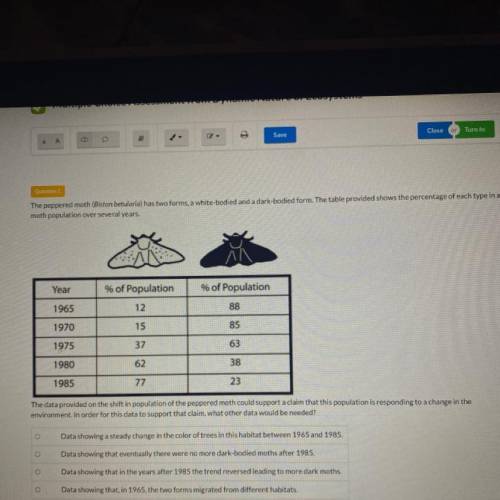
The peppered moth (Biston betularia) has two forms, a white-bodied and a dark-bodied form. The table provided shows the percentage of each type
moth population over several years.
Year
% of Population
% of Population
1965
12
88
1970
15
85
1975
37
63
1980
62
38
1985
77
23
The data provided on the shift in population of the peppered moth could support a claim that this population is responding to a change in the
environment. In order for this data to support that claim, what other data would be needed?
O
Data showing a steady change in the color of trees in this habitat between 1965 and 1985.
Data showing that eventually there were no more dark-bodied moths after 1985.
Data showing that in the years after 1985 the trend reversed leading to more dark moths.
Data showing that, in 1965, the two forms migrated from different habitats.


Answers: 3
Another question on Chemistry

Chemistry, 21.06.2019 23:30
Calculate the expected ph values of the buffer systems from the experiments (a,b,c,d), using the henderson- hasselbalch equation, ph-pka+log[a-]/[ha]. use for pka values carbonic acid= 6.37, and acetic acid= 4.75.
Answers: 2

Chemistry, 22.06.2019 14:00
What term describes technology that operates on an atomic level
Answers: 2

Chemistry, 22.06.2019 17:40
Experiment: effect of solution concentration on reaction rate you have learned that as the concentration of reactants increases, there will most likely be a greater number of collisions, and hence increase the rate of a reaction. in this experiment, you will see a demonstration of this, with a twist. there will be three reactions going on in this experiment. objectives determine how solution concentration can affect the rate of a reaction. the first reaction will be a reaction of the iodide ion (i-1) with hydrogen peroxide (h2o2) in an acidic solution. this reaction produces a slightly orange solution. in our experiment, we will add some orange food coloring to make this solution more orange. 2 h+ (aq) + 2 i- (aq) + h2o2 (aq) ⟶ i2 (aq) + 2 h2o (l) the next reaction will be between the iodine and starch i2 + starch ⟶ i2-starch complex (blue-black) so, when starch is added to the iodine solution made from the first reaction, the solution will turn black immediately, so it is difficult to find the rate of reaction. in order to be able to time this reaction, you will slow it down with another reaction. adding ascorbic acid will react with the iodine, reducing the concentration of the iodine available to react with the starch. c6h8o6 (aq) + i2 (aq) ⟶ 2i- (aq) + c6h6o6 (aq) + 2 h+ (aq) when the ascorbic acid is used up, the remaining iodine molecules can react with the starch and form the black color. the more ascorbic acid you add, the slower the reaction to form the iodine-starch complex will be. use your data and observations to complete the assignment. analysis and conclusions submit your data and the answers to these questions in the essay box below. what was your hypothesis? plot your data as drops of ascorbic acid vs. time. as the concentration of ascorbic acid was increased, did the rate of the formation of the iodine-starch complex increase or decrease? explain your answer in terms of the chemical reactions involved. was your hypothesis correct? make a general rule about the effects of concentration of reactants on reaction rates. for practice, the molecular formula for ascorbic acid is c6h8o6, and you used 6 g in this experiment, calculate the molarity of the ascorbic acid. now calculate the concentration in moles per drop (assume 1 ml = 20 drops).
Answers: 3

Chemistry, 22.06.2019 18:00
Which statement best describes the he properties of iconic compounds ?
Answers: 1
You know the right answer?
The peppered moth (Biston betularia) has two forms, a white-bodied and a dark-bodied form. The table...
Questions


Social Studies, 18.07.2019 14:30


English, 18.07.2019 14:30

History, 18.07.2019 14:30

Biology, 18.07.2019 14:30

Biology, 18.07.2019 14:30


Biology, 18.07.2019 14:30

Mathematics, 18.07.2019 14:30

Social Studies, 18.07.2019 14:30

Mathematics, 18.07.2019 14:30






Mathematics, 18.07.2019 14:30

Biology, 18.07.2019 14:30



